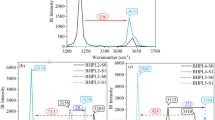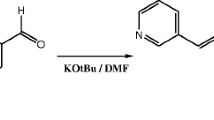Abstract
Pyrene-based Schiff base derivatives have attracted enormous potential as fluorescent probe for multifarious research applications due to their fashionable photophysical properties. In the present work, pyrene-based Schiff base derivatives of 4-[(pyren-1-ylmethylene)amino]phenol (PAP1-12) were computationally designed with hydroxyl (–OH) substitution at different positions on phenyl rings and have been studied using density functional theory (DFT) and time-dependent DFT (TD-DFT) methods. All the designed molecules were found to possess a coplanar geometry. PAP1-6 molecules with the phenol moiety substituted on the nitrogen atom of the C=N π-bridge were found to possess relatively small dipole moment values than PAP7-12 with phenol moiety substituted on the carbon atom of the C=N bridge that is flipped. Frontier molecular orbital (FMO) analysis divulged that HOMO to LUMO transition in PAP1-6 molecules is of π → π* character signifying that these molecules are potential aggregation-induced emission (AIE) molecules while PAP7-12 showed ICT character in correspondence with the order witnessed in dipole moment values. With regard to the HOMO–LUMO energy gap, PAP4 was estimated to show relatively small value than other molecules and as a result it exhibited the largest absorption maxima of 425 nm and large first hyperpolarizability value of 40 × 10–30 esu. On the other hand, PAP6 molecule possessed relatively larger emission λmax value of around 500 nm. In essence, the present work demonstrates that change in the substituents on the PAP derivatives and the flipping of C=N π-bridge rendered PAP1-6 suitable for AIE application and PAP7-12 for ICT application. This substituent dependency and effect of π-bridge flipping could be capitalized upon for future development of similar organic dyes for diverse applications.
Graphical abstract




Similar content being viewed by others
References
Luo J, Xie Z, Lam JWY, Cheng L, Chen H, Qiu C, Kwok HS, Zhan X, Liu Y, Zhu D, Tang BZ (2001) Aggregation-induced emission of 1-methyl-1,2,3,4,5-pentaphenylsilole. Chem Commun 11:1740
Mei J, Leung NL, Kwok RT, Lam JW, Tang BZ (2015) Aggregation-induced emission: together we shine, united we soar! Chem Rev 115:11718–11940
Gao M, Tang BZ (2017) Fluorescent sensors based on aggregation-induced emission: recent advances and perspectives. ACS Sens 2:1382–1399
Feng L, Shi W, Ma J, Chen Y, Kui F, Hui Y, Xie Z (2016) A novel thiosemicarbazone Schiff base derivative with aggregation-induced emission enhancement characteristics and its application in Hg2+ detection. Sens Actuat B Chem 237:563–569
Udhayakumari D (2018) Chromogenic and fluorogenic chemosensors for lethal cyanide ion. A comprehensive review of the year 2016. Sens Actuat B Chem 259:1022–1057
Shellaiah M, Wu YH, Singh A, Ramakrishnam RMV, Lin HC (2013) Novel pyrene- and anthracene-based Schiff base derivatives as Cu2+ and Fe3+ fluorescence turn-on sensors and for aggregation induced emissions. J Mater Chem A 1:1310–1318
Ghosh A, Sengupta A, Chattopadhyay A, Das D (2015) Lysine triggered ratiometric conversion of dynamic to static excimer of a pyrene derivative: aggregation-induced emission, nanomolar detection and human breast cancer cell (MCF7) imaging. Chem Commun 51:11455–11458
Shyamal M, Mazumdar P, Maity S, Sahoo GP, Morán GS, Misra A (2016) Pyrene Scaffold as real-time fluorescent turn-on chemosensor for selective detection of trace-level Al(III) and its aggregation-induced emission enhancement. J Phys Chem A 120:210–220
Li Y, Ma Z, Li A, Xu W, Wang Y, Jiang H, Wang K, Zhao Y, Jia X (2017) A Single crystal with multiple functions of optical waveguide, aggregation-induced emission, and mechanochromism. ACS Appl Mater Interfaces 9:8910–8918
Shyamal M, Maity S, Mazumdar P, Sahoo GP, Maity R, Misra A (2017) Synthesis of an efficient Pyrene based AIE active functional material for selective sensing of 2,4,6-trinitrophenol. J Photochem Photobiol A Chem 342:1–14
Kathiravan A, Sundaravel K, Jaccob M, Dhinagaran G, Rameshkumar A, Arul AD, Sivasudha T (2014) Pyrene Schiff base: photophysics, aggregation induced emission, and antimicrobial properties. J Phys Chem B 118:13573–13581
Srinivasan V, Asha JM, Dhenadhayalan N, Lin KC, Jaccob M, Kathiravan A (2017) AIE nanodots obtained from a pyrene Schiff base and their applications. ChemistrySelect 2:1353–1359
Fernández-Lodeiro J, Núñez C, de Castro CS, Bértolo E, de Melo JSS, Capelo JL, Lodeiro C (2013) Steady-state and time-resolved investigations on pyrene-based chemosensors. Inorg Chem 52:121–129
Milan S, Prativa M, Samir M, Gobinda PS, Guillermo S-M, Ajay M (2016) Pyrene Scaffold as real-time fluorescent turn-on chemosensor for selective detection of trace-level Al(III) and its aggregation-induced emission enhancement. J Phys Chem A 120:210–220
Kathiravan A, Karuppasamy S, Jaccob M, Ganesan D, Angappan R, Devanesan AA, Thilagar S (2014) Pyrene Schiff base: photophysics, aggregation induced emission, and antimicrobial properties. J Phys Chem B 118:13573–13581
Frisch MJ, Trucks GW, Schlegel HB, Scuseria GE, Robb GE, Cheeseman JR, Scalmani G, Barone V, Mennucci B, Petersson GA et al (2009) Gaussian 09, revision D.01. Gaussian Inc., Wallingford
Perdew JP, Burke K, Ernzerhof M (1996) Generalized gradient approximation made simple. Phys Rev Lett 77:3865–3868
Cossi M, Barone V, Cammi R, Tomasi J (1996) Ab initio study of solvated molecules: a new implementation of the polarizable continuum model. Chem Phys Lett 255:327–335
Reed AE, Curtiss LA, Weinhold F (1988) Intermolecular interactions from a natural bond orbital, donor-acceptor viewpoint. Chem Rev 88:899–926
Janjua MRSA, Khan MU, Bashir B, Iqbal MA, Song Y, Naqvi SAR, Khan ZA (2012) Effect of π-conjugation spacer (CC) on the first hyperpolarizabilities of polymeric chain containing polyoxometalate cluster as a side-chain pendant: a DFT study. Comput Theor Chem 994:34–40
Acknowledgements
MJ sincerely acknowledges the Department of Science and Technology (DST), New Delhi, India, for the financial support provided through DST-Inspire Faculty award (Ref. No. IFA13-CH-100). Authors also thank the Loyola College Management and Director, Loyola Institute of Frontier Energy (LIFE), Loyola College, Chennai, for the infrastructural support to carry out the research work.
Author information
Authors and Affiliations
Corresponding authors
Ethics declarations
Conflict of interest
The authors declare no competing financial interest.
Additional information
Handling Editor: M. Grant Norton.
Publisher's Note
Springer Nature remains neutral with regard to jurisdictional claims in published maps and institutional affiliations.
Supplementary Information
Below is the link to the electronic supplementary material.
10853_2022_7095_MOESM1_ESM.docx
Supplementary file1 (DOCX 4751 kb) Optimized structures of selected pyrene-based Schiff bases in the gas phase obtained at the PBE0/6-311+G(d,p) level of theory, electron density distribution of HOMOs and LUMOs of selected pyrene-based Schiff bases in the gas phase obtained at the PEB0/6-311+G(d,p) level of theory, calculated frontier molecular orbital contribution of PAP derivatives
Rights and permissions
About this article
Cite this article
Panneerselvam, M., Kathiravan, A., Johnee Britto, N. et al. Delineating the effect of substituent and π-bridge flip on the photophysical properties of pyrene derivatives: answers from DFT/TD-DFT calculations. J Mater Sci 57, 10724–10735 (2022). https://doi.org/10.1007/s10853-022-07095-x
Received:
Accepted:
Published:
Issue Date:
DOI: https://doi.org/10.1007/s10853-022-07095-x




